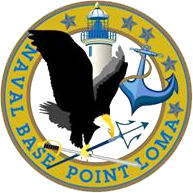Naval Base Point Loma
 |  | |

Naval Base Point Loma (förkortning: NBPL) är en örlogsbas tillhörande USA:s flotta som är belägen på halvön Point Loma i San Diego, Kalifornien.[1]
Bakgrund
Den spanska kolonialmakten byggde Fort Guijarros (spanska: Castillo de Guijarros) vid inloppet till San Diego-bukten år 1797.[2] Under det Mexikansk-amerikanska kriget 1846 landsteg amerikanska marinsoldater vid La Playa (se äldre karta till höger) och tog kanoner från det övergivna Fort Guijarros och belägrade San Diego. 1873 tog USA:s armé över det övergivna fortet som byggdes ut under namnet Fort Rosecrans och som tjänstgjorde som en del av kustartilleriet under både första och andra världskriget. Fort Rosecrans överfördes till flottan 1959 och den nuvarande basen för atomubåtar byggdes mellan 1962 och 1963.
Från juni 2005 till augusti 2007 var den svenska ubåten HMS Gotland stationerad vid Point Loma Naval Base.[3]
Organisation
På NBPL finns högkvarteret för USA:s tredje flotta, regionkommandot för Military Sealift Command. I organisationen för NBPL ingår Naval Information Warfare Systems Command (NAVWAR), Naval Information Warfare Center Pacific (NIWC Pacific) samt militärfängelset Naval Consolidated Brig, Miramar (som rent fysiskt ligger på Marine Corps Air Station Miramar).
NBPL har en personalstyrka på 22 000 militärer och civilanställda.
Fartyg
5 atomdrivna attackubåtar av Los Angeles-klass som ingår i Submarine Squadron 11 (SUBRON 11):
- USS Pasadena (SSN-752)
- USS Scranton (SSN-756)
- USS Alexandria (SSN-757)
- USS Annapolis (SSN-760)
- USS Hampton (SSN-767)
Dessutom ett antal torpedbärgare samt en flytdocka.
Se även
- Marine Corps Recruit Depot San Diego
- Naval Base Coronado
- Naval Base San Diego
- Naval Base Ventura County
Referenser
- Den här artikeln är helt eller delvis baserad på material från engelskspråkiga Wikipedia, Naval Base Point Loma, tidigare version.
- ^ ”California Military Installations and Operational Areas” (på engelska). militarycouncil.ca.gov. State of California. 2021. https://militarycouncil.ca.gov/s_californiamilitarybases/. Läst 8 november 2021.
- ^ Ruhlen, George. ”Historic California Posts - Fort Rosecrans (Including Castillo de Guijarros and Point Loma Military Reservation)”. MilitaryMuseum.org (The California State Military Museum). http://www.militarymuseum.org/FtRosecrans.html. Läst 2 mars 2008.
- ^ ”En svensk ubåt i Amerika”. www.forsvarsmakten.se. Försvarsmakten. 18 februari 2020. https://www.forsvarsmakten.se/sv/information-och-fakta/var-historia/artiklar/en-svensk-ubat-i-amerika/. Läst 12 juli 2022.
Externa länkar
- www.cnic.navy.mil/PointLoma
 Wikimedia Commons har media som rör Naval Base Point Loma.
Wikimedia Commons har media som rör Naval Base Point Loma.
Media som används på denna webbplats
Insignia of the U.S. Naval Base Point Loma, California (USA), in 2018.
SAN DIEGO (June, 10 2010) The amphibious assault ship USS Boxer (LHD 4) passes Naval Base Point Loma (NBPL) as it enters San Diego Bay after completing routine work-ups off the of California coast. Boxer is underway for the first time in nearly nine months to conduct sea trials following a dry dock planned maintenance availability. (U.S. Navy photo by Chief Mass Communication Specialist Bill Gowdy/Released)
This is the most attractive map of San Diego Bay, California, to emerge from the work of the U.S. Coast Survey. Covers the San Diego area from False Bay and the Valley of Las Yeguas southward past Mission Valley and San Diego city to San Diego Bay and the villages of La Punta and the Valley of Ohjia. Offers superb detail both inland and at sea. Inland detail includes topographical features, rivers, roads, and villages. Villages and cities, including San Diego, La Playa, New San Diego, and others, are detailed to the level of individual buildings. Nautical details include innumerable depth sounding, breakwaters, and notes on the Kelp Beds off the coast of Point Loma. Lower left quadrant features textual sailing instructions as well as notes on the tides and a history of the chart. This cart was prepared under the supervision of A. D. Bache for inclusion in the 1857 edition of the Report of the Superintendent of the United States Coast Survey . The triangulation for this chart was accomplished by R. D. Cutts, the topography by A. M. Harrison, and the hydrography by a party under the command of James Alden.


